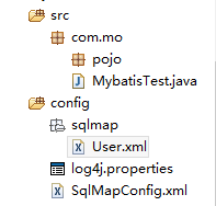Demand:
1. Query a user
2. Query multiple users (List)
Step 1: Make a global configuration file under config/SqlMapConfig.xml (note header information)

<?xml version="1.0" encoding="UTF-8" ?> <!DOCTYPE configuration PUBLIC "-//mybatis.org//DTD Config 3.0//EN" "http://mybatis.org/dtd/mybatis-3-config.dtd"> <configuration> <!-- Configuring data sources --> <!-- and spring After integration environments Configuration will be abolished--> <environments default="development"> <environment id="development"> <transactionManager type="JDBC" /> <dataSource type="POOLED"> <property name="driver" value="com.mysql.jdbc.Driver" /> <property name="url" value="jdbc:mysql://localhost:3306/mybatis?characterEncoding=utf-8" /> <property name="username" value="root" /> <property name="password" value="root" /> </dataSource> </environment> </environments> <!-- To configure mapper Mapping file --> <mappers> <mapper resource="sqlmap/User.xml"/> </mappers> </configuration>
Adding config/log4j.properties can print sql statements on the console
Step 2: Create Entity Classes User.java
Step 3: Configure the User.xml mapping file under config/sqlmap/User.xml (note header information)
<?xml version="1.0" encoding="UTF-8" ?>
<!DOCTYPE mapper
PUBLIC "-//mybatis.org//DTD Mapper 3.0//EN"
"http://mybatis.org/dtd/mybatis-3-mapper.dtd">
<! -- namespace namespace: As a token, but if you use the mapper dynamic proxy method, you need to configure the mapper interface address here - >.
<mapper namespace="test">
<!--
Query a record based on the user's ID (return a single record)
The select tag represents the sql query, and the content is encapsulated in Mapped Statement.
You can call this select tag a Statement.
id attribute: the unique identity of the Statement
# {}: Represents a placeholder that avoids sql injection
${}: Represents a splicer
parameterType: Represents the type of input, that is, what type of placeholder to enter
ResultType: The type representing the output result set, and the field name of the select query is the same as the resultType attribute name to map successfully.
# {id}:id represents the variable for the parameter input parameter
-->
<select id="findUserById" parameterType="int" resultType="com.mo.pojo.User">
SELECT * FROM USER WHERE id = #{id}
</select>
<!--
Query the list of users by name (return to the List collection)
Regardless of how many results are returned, resultType specifies the type of a single record mapping java object
${}: Represents sql splicing, which is equivalent to splicing sql strings, and sql injection is unavoidable.
${value}:value represents the variable for the parameter input parameter. With ${}, the variable name must use value.
Splice value directly into sql without any modification
'%${value}%': Modification can be used in this way
Client input sheet
sql splices to% sheet%
-->
<select id="findUserListByName" parameterType="String" resultType="com.mo.pojo.User">
SELECT * FROM USER WHERE username LIKE '%${value}%'
</select>
</mapper>
Step 4: Test Unit
package com.mo;
import java.io.IOException;
import java.io.InputStream;
import java.util.List;
import org.apache.ibatis.io.Resources;
import org.apache.ibatis.session.SqlSession;
import org.apache.ibatis.session.SqlSessionFactory;
import org.apache.ibatis.session.SqlSessionFactoryBuilder;
import org.junit.Test;
import com.mo.pojo.User;
public class MybatisTest {
@Test
public void test() throws IOException{
//1. Loading configuration files
String resource = "SqlMapConfig.xml";
InputStream inputStream = Resources.getResourceAsStream(resource);
//2. Create SqlSessionFactory based on configuration file
SqlSessionFactory sqlSessionFactory = new SqlSessionFactoryBuilder().build(inputStream);
//3. Create SqlSession according to SqlSession Factory
SqlSession sqlSession = sqlSessionFactory.openSession();
//4. Query returns multiple entries
/**
* Operating the database through the API of sqlSession
* The first parameter is statement: specify the id of the state in the mapper mapping file
* When specified, add the space name to which the state belongs
* The second is to assign parameters.
*
* selectOne Returns a single record, and if select returns multiple records (list collection), selectOne will report an error.
*
* Returning a worthwhile type is the resultType in the mapping file
*/
User user = sqlSession.selectOne("test.findUserById", 1);
List<User> list = sqlSession.selectList("test.findUserListByName","Zhang");
System.out.println(list.size());
System.out.println(user);
//5. Close sqlSession
sqlSession.close();
}
}